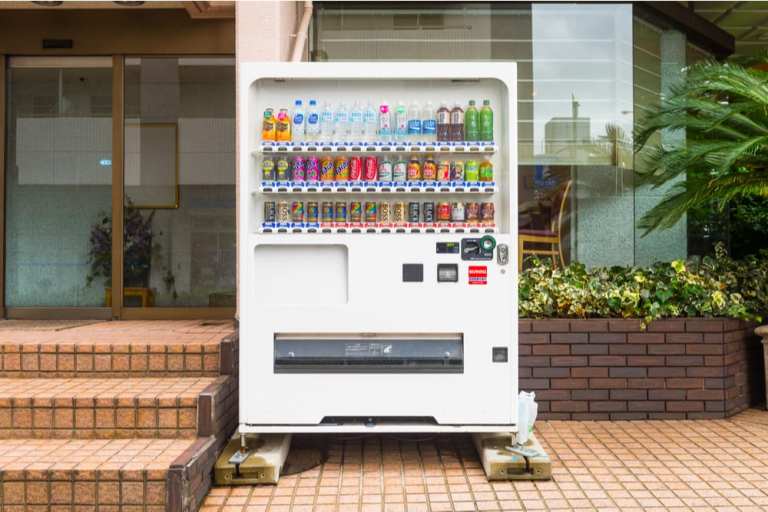To help consumers conveniently access their favorite products, retailers are offering a wide array of merchandise through automated retail technology. These innovations have arrived in a broad range of spaces, from brick-and-mortar stores to offices – and their designs are not limited to the vending machines that have sold candy and soda for years.
According to The Future of Unattended Retail Report from PYMNTS, “Unattended retail touchpoints populate a broad and diverse set of locations, and have taken various shapes and forms.” Examples include touchscreen vending machines that tell buyers about nutritional data, kiosks that sell electronic gear in airports and automated electronic massage chairs.
From Amazon to Blanchard’s Coffee Roasting Co., large eCommerce retailers and local businesses alike are tapping into the world of unattended retail. These are just a few examples of how merchants are harnessing technologies such as kiosks and cashierless stores to serve shoppers through a variety of retail settings:
More than half – or 52.3 percent – of all consumers whose latest purchases were unattended reported buying food and beverages. And quick-service restaurants (QSRs) are allowing consumers to order pizza from their vehicles. Domino’s Pizza, in one instance, was bringing in-car ordering to new vehicles last year via a pre-loaded ordering platform dubbed AnyWare. The offering, which is powered via an automotive commerce platform dubbed Xevo Market, enables consumers to use the touchscreen on their vehicles to place orders. Domino’s Director of Digital Experience Chris Roeser said in an announcement about the offering at the time, “At Domino’s, we want pizza ordering to be simple and always within reach, no matter where a customer happens to be.” The restaurant chain said that logged-in customers can save time by asking for their most recent order.
Just under 16 percent – or 15.6 percent – of unattended retail shoppers made their most recent unattended purchases at a retail store. Coffee roasters, for instance, are putting vending machines outside of their buildings. Blanchard’s Coffee Roasting Co. has a custom vending machine at its front door. The machine doesn’t take cash – shoppers can swipe their cards (or tap with Apple Pay or Google Pay) to make a purchase. The company examined its existing data to decide what to stock in the machine. The selections are said to be a combination of what’s exciting, what’s new and old favorites. Beyond coffee and merchandise, Blanchard’s also carries a V60 filter made by Hario in the machine.
More than 13 percent – or 13.4 percent – of unattended retail shoppers made their most recent unattended purchases at a grocery store. eCommerce retailers are aiming to serve this group with new concepts. News recently surfaced, for instance, that Amazon was opening its first cashierless grocery store in Seattle. Amazon Go Grocery, which is located in the Capitol Hill section of Seattle, is selling approximately 5,000 stocked items in its roughly 10,400-square-foot store, with the inclusion of meats, fresh produce and alcohol. The original Go concept is more of a convenience store aiming to serve office workers. Go Grocery, on the other hand, is a full-fledged supermarket looking to reach consumers in residential neighborhoods. Cameron Janes, vice president of Amazon’s physical retail division, said per reports, “We’re not trying to be Whole Foods. We’re not trying to replace them.”
Advertisement: Scroll to Continue
Just under four in 10 – or 38.4 percent – of consumers who made their most recent purchases from unattended channels would like to use them to shop for non-traditional vending products. The Sock Spot, in one case, has a vending machine for socks. The machine is “kind of different from some of the other vending machines that you see,” CEO Ben Williams said in a previous PYMNTS interview, noting that “it’s all just one touchscreen” with a grid of different products. Shoppers can tap on an item to get more information and purchase the socks through a buy-it-now experience. They can swipe their card to have an item dispensed, or they can add multiple items to their cart, adjust the number of items as needed and then check out.
Just under 9 percent – or 8.9 percent – of unattended retail shoppers made their most recent unattended purchases at an office. Food delivery platforms are serving these customers with automated retail. nutrimeals, in one case, has a pilot of kiosks that are stocked with fresh and prepared meals in office towers. Diners can tap into the technology much as they would use a traditional vending machine. A large touchscreen displays nutrition facts and ingredients, providing the information diners need to know in the event that they have allergies or dietary restrictions. The machine can vend up to three meals per transaction. After consumers have made their selections, they can pay via credit card or Apple Pay. Diners will be able to order meals through an app in the future, but they currently have to use the kiosk’s touchscreen.
From nutrimeals to Amazon, technology providers and eCommerce merchants alike are harnessing innovation with unattended retail. While only 14.4 million U.S. consumers currently shop at unattended retail locations, an additional 48.6 million would like to do so. Heading into the future, unattended retail stands as a significant opportunity for competitive retailers to offer unattended shopping options where consumers are most likely to purchase their merchandise.




